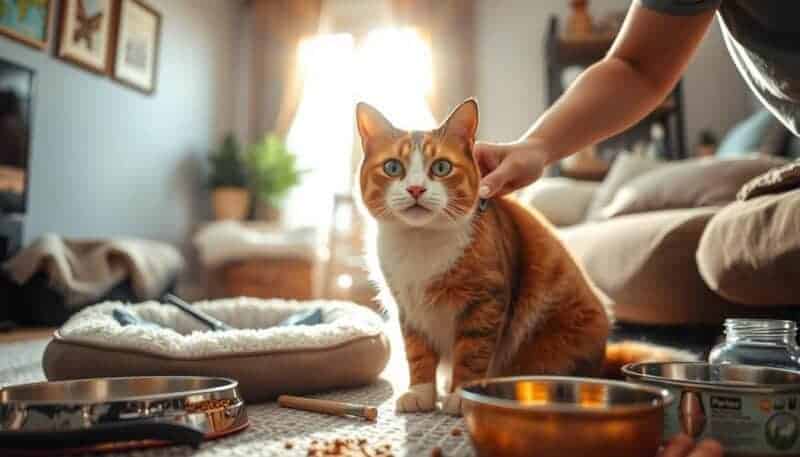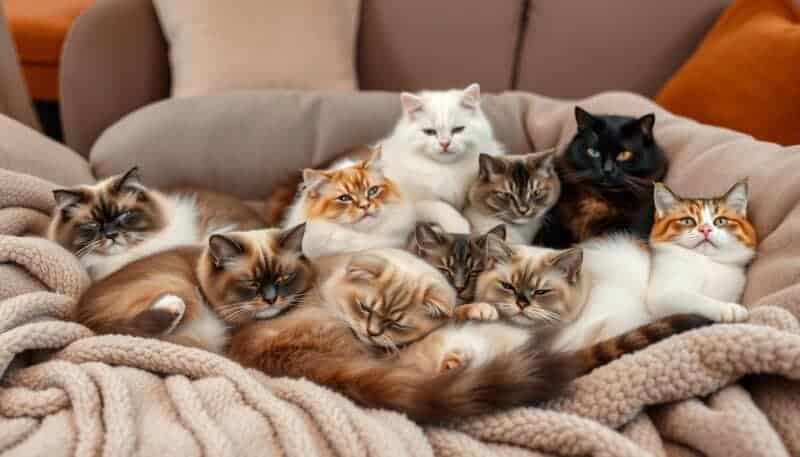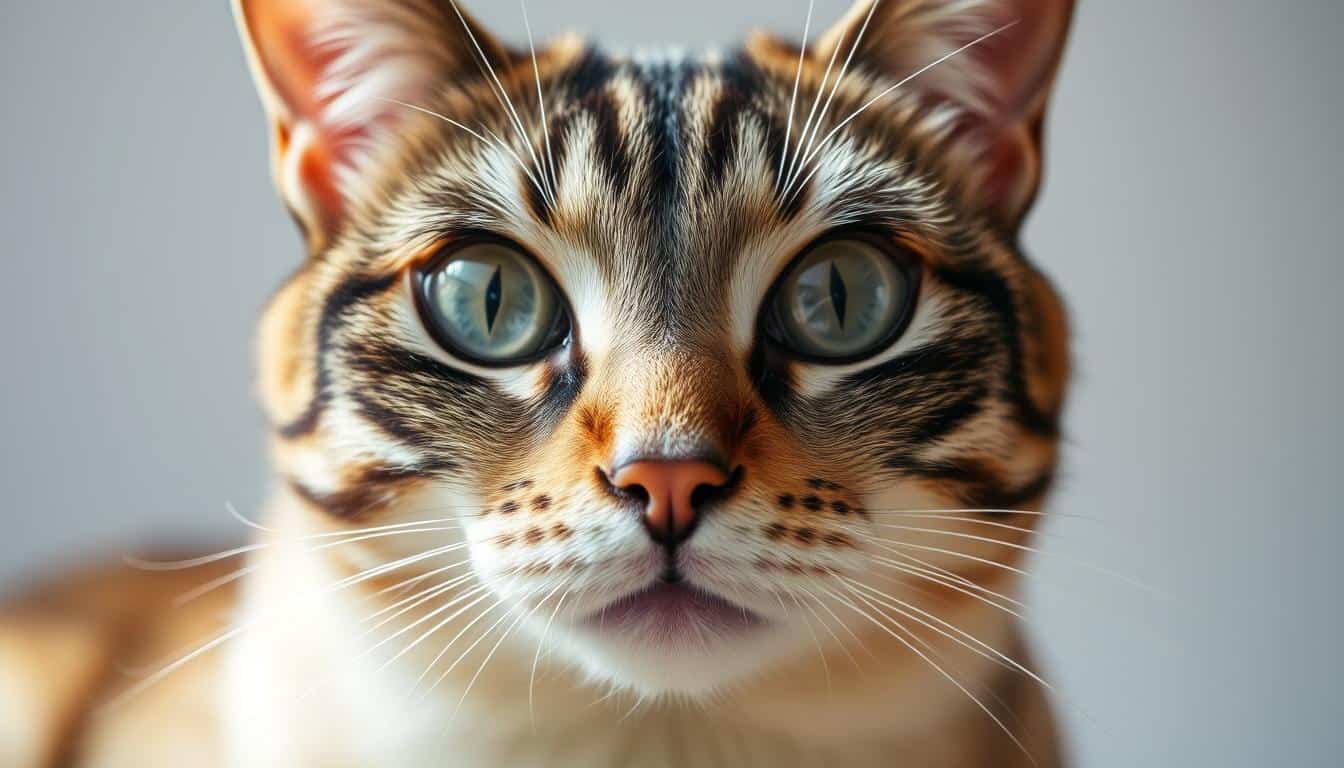Introduction
I’ve always loved cats, especially the flat face breeds. Their cute faces and charming personalities win many hearts. This guide will explore the world of these special cats, perfect for those thinking of getting one or just curious.
You’ll learn about flat face cats’ key traits, the most popular breeds, and how to care for them. This guide will help you understand their needs and the joys of owning a flat face cat. It’s packed with tips to ensure your cat stays healthy and happy.
- Understanding Flat Face Cats
- Popular Flat Face Cat Breeds
- The Health of Flat Face Cats
- Caring for Your Flat Face Cat
- Choosing the Right Flat Face Cat for You
- Recognizing Flat Face Cat Temperaments
- Understanding the Cost of Ownership
- Flat Face Cats in Popular Culture
- Training Techniques for Flat Face Cats
- Myths and Misconceptions About Flat Face Cats
- Resources for Flat Face Cat Owners
- FAQ:
- What are the cats with flat faces called?
- Are flat faced cats healthy?
- What breed of cat has a flat nose?
- What defines a flat face cat?
- What are the common characteristics of flat face cats?
- Why do flat face cats exist?
- What are some popular flat face cat breeds?
- How do I care for a flat face cat?
- What should I consider when choosing a flat face cat?
- What are some myths and misconceptions about flat face cats?
Understanding Flat Face Cats
Exploring the world of flat face cats, also known as brachycephalic breeds, is fascinating. These cats have a unique look due to their compressed faces and short muzzles. This can affect their health and happiness.
What Defines a Flat Face Cat?
Flat face cats, or brachycephalic breeds, have a flat face and a short snout. Breeders have made these cats through selective breeding. This makes them look different from other cats, with a squished face.
Common Characteristics of Flat Face Cats
- Shortened muzzle and compressed facial structure
- Larger, more prominent eyes that can protrude slightly
- Rounded, domed-shaped head
- Relatively small, upturned nose
- Wrinkled skin around the face and head
Health Considerations for Flat Face Cats
Flat face cats are loved for their looks, but they face health challenges. Their face shape can lead to breathing problems. They might find it hard to breathe, especially when stressed or active. They also struggle with heat.
| Potential Health Concerns | Causes |
|---|---|
| Respiratory problems | Compressed facial structure and shortened muzzle |
| Eye issues | Prominent, protruding eyes |
| Heat intolerance | Difficulty regulating body temperature |
Knowing about flat face cats’ traits and health issues is key for owners. It helps them care for these special cats better.
Popular Flat Face Cat Breeds
Several flat face cat breeds are very popular. The Persian, Exotic Shorthair, and Scottish Fold are favorites. They win hearts with their looks and personalities.
The Persian Cat: A Classic Choice
The Persian cat is famous for its flat face and long coat. It’s a calm and loving pet. Persians love being around their owners and enjoy indoor life.
The Exotic Shorthair: Persian’s Playful Cousin
The Exotic Shorthair is playful and has a short coat. It’s a fun choice for those who want a lively pet. They are full of energy and brighten any home.
The Scottish Fold: Unique Ears, Unique Face
The Scottish Fold has folded ears and a flat face. It’s a special cat with a gentle and curious nature. They are great for families and individuals.
Choosing a flat face cat breed means getting a charming pet. You can pick the Persian, Exotic Shorthair, or Scottish Fold. Each one brings something unique to your life.
The Health of Flat Face Cats
Flat face cats are fascinating, but their looks come with health risks. It’s important to know these risks and take steps to help them stay healthy.
Genetic Conditions to Be Aware Of
Flat face cats face many health problems. These include breathing issues, tear problems, and more. These issues could affect their well-being and comfort. their lives.
Importance of Regular Veterinary Check-ups
Flat face cats need special care because of their health issues. Regular vet visits are key. They help catch problems early and keep your cat healthy and happy.
“Proper veterinary care and early intervention are crucial for maintaining the health and well-being of flat face cats.”
Caring for Your Flat Face Cat
Owning a flat face cat, like a Persian or Exotic Shorthair, needs extra care. They need special grooming and a specific diet. Knowing how to care for them is key to their health and happiness.
Grooming Needs for Flat Face Cats
Flat face cats have thick, beautiful fur that needs regular grooming. They should be brushed often to avoid mats and keep their skin clean. They also need baths every 4-6 weeks to stay clean and smell good.
For cats with very thick fur, professional grooming might be needed. This helps keep their fur in check.
Dietary Requirements and Recommendations
Flat face cats have special diet needs because of their face shape and breathing. They should eat high-quality, low-protein cat food made for flat face breeds. It’s important to control their food portions to avoid weight gain.
Always have fresh water available. Wet food can help keep them hydrated and prevent urinary problems.
Exercise and Play Time
Even though flat face cats are less active, they still need exercise and play. Give them toys, cat trees, and playtime to keep them active and happy. They like short play sessions followed by naps.
| Grooming Needs | Dietary Requirements | Exercise and Play |
|---|---|---|
|
|
|
Understanding your flat face cat’s grooming, diet, and play needs is crucial. In this way, you’ll be able provide them with the highest level of care. They will live a happy, healthy life with you.

Choosing the Right Flat Face Cat for You
Adopting a flat face cat is a big decision. You might love the cute looks of a Persian or the fun vibe of an Exotic Shorthair. But, it’s key to know the special needs and challenges these cats have.
Adopting from Shelters vs. Breeders
There are two main ways to get a cat: from a shelter or a breeder. Adopting from a shelter is rewarding, as you help a cat in need and save money. But, make sure the cat’s health and personality fit what you want.
Choosing a breeder means you get to know more about the cat’s health and traits. Good breeders care about their cats and help you find the perfect one for you.
Questions to Ask Before Adoption
- What are the specific health and grooming needs of this flat face cat breed?
- Does the cat have any genetic conditions or breathing issues I should be aware of?
- How much time and energy will this cat require on a daily basis?
- Is this cat well-suited for my living space and family environment?
- What is the cat’s temperament, and how does it interact with children or other pets?
The answers to these questions will help you make an informed decision. It ensures you can give your new cat the best care.
Recognizing Flat Face Cat Temperaments
Flat face cats, like the Persian and Exotic Shorthair, have special personalities. They are playful and loving, making great friends. Knowing their traits helps decide if they’re right for your family.
Playfulness and Personality Traits
These cats love being around people and are very playful. They enjoy toys and spending time with their owners. But, they also like to relax and just be with you.
Interaction with Children and Other Pets
Flat face cats are good with kids who treat them gently. They are calm and love attention, making them great family pets. They can get along with dogs or other cats, but it’s important to introduce them carefully.
Understanding a flat face cat’s personality and how they interact helps you decide if they’re right for you.

Understanding the Cost of Ownership
Bringing a flat face cat into your home can be very rewarding. But, it’s key to know the financial side. This includes the initial cost, adoption fees, and ongoing care and vet bills.
Initial Purchase Price or Adoption Fees
The cost to get a flat face cat varies a lot. Buying from a good breeder can cost between $500 and $2,000. This depends on the cat’s breed, pedigree, and more. On the other hand, adopting from a shelter or rescue can be cheaper, usually between $100 and $300.
Ongoing Veterinary and Care Expenses
Flat face cats need more vet visits because of their special faces and breathing. These visits, dental cleanings, and treatments for breathing problems can be expensive. The yearly costs can be from $500 to $1,500 or more. Also, their grooming needs are high, which can cost $50 to $100 every 4-6 weeks for a professional groom.
| Expense | Cost Range |
|---|---|
| Initial Purchase Price or Adoption Fees | $100 – $2,000 |
| Annual Veterinary Care | $500 – $1,500+ |
| Professional Grooming (every 4-6 weeks) | $50 – $100 per session |
Knowing the costs of owning a flat face cat helps you decide. It ensures you can give your cat the best care financially.
Flat Face Cats in Popular Culture
The charm of flat face cats, or snub-nosed felines, has spread beyond just being pets. They’ve made their mark in popular culture. From the famous Persian cat in movies to social media stars, they’ve won over fans everywhere.
Famous Flat Face Cats in Movies and Media
The Persian cat has been a favorite on screen for years. They’ve appeared in many films and TV shows. These cats are known for their elegance, fluffiness, and as the perfect home pet.
Classic movie fans might remember the Persian cats in “Breakfast at Tiffany’s” and “Meet the Parents.”
Social Media Stars: Cats with Flat Faces
In today’s world, flat face cats are internet sensations. They have millions of fans on Instagram and TikTok. Their cute faces and fun personalities have won over people all over.
These “CatFluencers” are changing how we see pets. They make us talk about the special charm of snub-nosed felines.
“These flat face cats have a way of capturing our hearts and imaginations, seamlessly blending into the fabric of popular culture.”
The love for flat face cats keeps growing. They’ve made a big impact in movies and online. These lovable friends have become icons, showing us the beauty and unique personalities of snub-nosed felines.
Training Techniques for Flat Face Cats
Owning a flat face cat, also known as a brachycephalic breed, needs a special training approach. These cats have unique physical traits that affect their behavior and how they learn. Knowing what flat face cats need helps you train them well, making them happy and well-behaved.
Litter Training Essentials
Litter training is key for flat face cat owners. Their short muzzles can make regular litter boxes hard to use. Try a bigger, open-top litter box to fit their face shape better. Keeping the litter clean and scooping it often helps with training.
Behavior Training Tips and Tricks
- Positive reinforcement is key: Flat face cats do best with rewards like treats or praise for good behavior.
- Adapt training sessions: Make training short and fun, as their short attention span is due to their face shape.
- Encourage playtime: Use interactive toys and play often to keep their energy up and teach good habits.
- Consult a professional: If you face challenges, a cat trainer or behaviorist can help.
Understanding and using these training tips for flat face cats can strengthen your bond. It ensures they are happy and well-behaved.
“Patience and consistency are key when training a flat face cat. These special felines require a gentle, rewards-based approach to help them thrive.”
Myths and Misconceptions About Flat Face Cats
Flat face cats, or brachycephalic breeds, have many myths and misconceptions. They’ve become popular, but their looks have led to misunderstandings. Let’s clear up the facts from fiction.
Debunking Common Myths
One myth is that flat face cats are always unhealthy. While some may face health issues, the right care can help. With proper vet visits and attention, they can live happy, healthy lives.
Another myth is that these cats are aggressive or hard to train. But, they are known for being playful and gentle. With patience and positive training, they can learn just like any cat.
Understanding the Reality
- Flat face cats need special grooming and care to stay healthy and look good.
- Good breeders focus on their cats’ health, working to avoid genetic problems.
- With the right diet, exercise, and vet visits, these cats can live well and bond with their owners.
Knowing the truth about flat face cats helps you decide if they’re right for you. With the right care, they can be loving and joyful companions.
Resources for Flat Face Cat Owners
As a flat face cat owner, you have many resources at your disposal. You can find books and online communities that are full of helpful information. These places are great for connecting with others who love these special cats.
Recommended Books and Online Communities
Looking to learn more about flat face cats? Check out “The Brachycephalic Cat Handbook” or “Caring for Your Flat-Faced Feline.” These books are packed with tips on how to care for these cats.
Online forums and Facebook groups for snub-nosed felines are also great. They let you share your experiences, ask questions, and learn from others. It’s a great way to connect with other owners.
Organizations and Support Groups
There are groups and organizations that focus on the welfare of flat face cats. The Brachycephalic Obstructive Airway Syndrome (BOAS) Working Group and the Brachycephalic Breed Council are two examples. They work to improve the health and care of these cats.
These groups offer advice, educational materials, and chances to meet others. They help you understand the joys and challenges of owning a flat face cat.
FAQ:
What are the cats with flat faces called?
Cats with flat faces are commonly referred to as flat face cats or brachycephalic cats. Breeds like the Persian, Exotic Shorthair, and British Shorthair possess this distinctive feature. Their short, rounded faces give them a unique appearance, but this facial structure can also lead to health concerns, particularly respiratory issues.
Are flat faced cats healthy?
Flat face cats like Persians and Exotic Shorthairs often face health challenges due to their brachycephalic structure. While they can live long, happy lives, their flattened faces can lead to respiratory issues, dental problems, and eye conditions. Regular veterinary care is essential to manage these potential health concerns.
What breed of cat has a flat nose?
The flat face cat breed most commonly associated with a flat nose is the Persian. This breed, along with the Exotic Shorthair, exhibits a brachycephalic facial structure. The short, rounded face and flattened nose are defining features, resulting from generations of selective breeding. However, these traits can also lead to respiratory concerns.
What defines a flat face cat?
Flat face cats, also known as brachycephalic breeds, have a short muzzle. This makes them look different from other cats.
What are the common characteristics of flat face cats?
They have big, round eyes and a flat nose. They might also have breathing problems and need extra grooming.
Why do flat face cats exist?
Flat face cats exist due to selective breeding, particularly in breeds like the Persian and Exotic Shorthair. The brachycephalic trait, which shortens the skull, results in their distinctive flat faces. While their appearance is adored by many, it can lead to respiratory and dental issues, making them more susceptible to certain health concerns.
What are some popular flat face cat breeds?
Popular breeds include the Persian, Exotic Shorthair, and Scottish Fold. They are known for their looks and loving nature.
How do I care for a flat face cat?
They need regular grooming, a balanced diet, and playtime. This keeps them healthy and happy.
What should I consider when choosing a flat face cat?
Research the breed and consider adoption or reputable breeders. Ask about health and temperament to find the right cat for you.
What are some myths and misconceptions about flat face cats?
Many myths exist about their health and care. It’s crucial to understand the truth to care for them properly.
Share your thoughts in the comments below! If you enjoyed this post, consider subscribing to our newsletter for more pet tips, stories and blogs!

